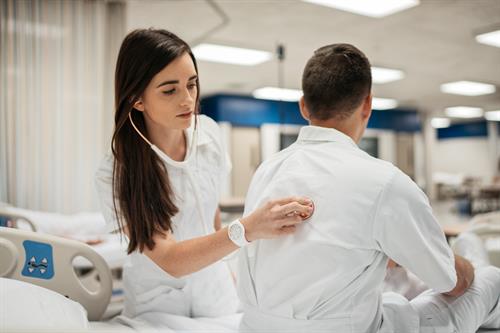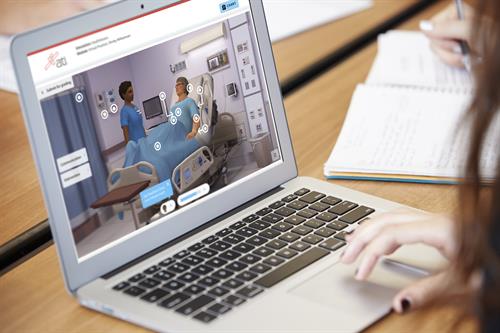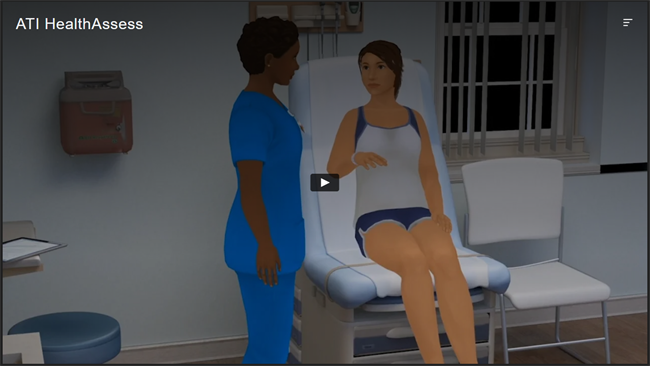WHY CLINICAL TEACHING MUST START IN THE CLASSROOM
Jan 4, 2021, 11:11 AM
<7.45-min. read> Teaching clinical to nursing students must change — and here’s 6 crucial reasons why it needs to start in the classroom.
IT'S ALL PART OF PREPARING STUDENTS FOR NEXT GEN NCLEX
Tap. Tap. Tap.
The student’s finger pressed firmly against his fellow student’s mid-back area as he tapped with his dominant plexor. He repeated the percussion, moving back and forth up to the chest wall. He listened intently to the quality of the sound, comparing each lung level side by side.
Was it resonant? Was it dull? Was it tympanic?
 After much practice on friends, tables, and other surfaces, he was ready to test his new skill on a real client during clinicals.
After much practice on friends, tables, and other surfaces, he was ready to test his new skill on a real client during clinicals. Back in the classroom, however, he was one of many students who mentioned to his instructor that he never saw nurses performing the technique. Plus, he found no place to document it.
Beth Phillips, PhD, RN, CNE, associate professor in the School of Nursing at Duke University and director of the Institute of Educational Excellence, decided to look into the issue.
Her research revealed that percussing of lungs was created before the advent of stethoscopes. But once those tools were created, in about the mid-1800s, the procedure was no longer necessary unless stethoscopes were not available.
“Yet we kept it going,” she said. “To this day, there are schools teaching it — and the books have it — and it’s really not even necessary, because we can actually get better breath sounds listening with the stethoscope than we ever could with percussion.”
The revelation led Dr. Phillips to step back and re-examine what was being taught in the clinical experience.
 “I saw that faculty and clinical instructors were spending just an exorbitant amount of time with students in the lab, teaching them all kinds of skills, checking them off in head-to-toe assessments — very in-depth — and, then, the students would go to clinical and not see many of those things ever performed,” she explained.
“I saw that faculty and clinical instructors were spending just an exorbitant amount of time with students in the lab, teaching them all kinds of skills, checking them off in head-to-toe assessments — very in-depth — and, then, the students would go to clinical and not see many of those things ever performed,” she explained.Ultimately, Dr. Phillips related six factors that have changed her approach to teaching clinical. And they all start with the classroom instructor.
Factor 1: Many nursing schools are teaching obsolete skills for clinical.
Classroom instructors can get an idea whether their clinical teaching techniques are relevant by taking a peek at the fields in today’s electronic health record (EHR) systems.When her school began examining these areas, Dr. Phillips said the faculty realized it had not stayed up to date.
“Many aspects of health assessment, for example, have changed over time or morphed into advanced-practice skills that have been added,” she said. Those newer skills weren’t even necessarily appropriate for a nurse generalist today, she added.
“We were having students do things that are really considered advanced practice or even provider skills — checking for CVA tenderness, for example. Doing reflexes on everyone. Nurses at the bedside don’t do those things unless they are in special care areas. Even out in clinics they don’t, unless they work in a very big, specialty clinic where they get special training,” she said.
She cited other reasons for continuing to instruct on out-of-date skills such as tradition or not updating curriculum as technology advanced. She noted, too, “I think part of it stemmed from we’re worried, as educators, about what’s on NCLEX. And we’re also thinking about what’s in all the health assessment books.”
Despite the complexities, her team decided it was time for a change. “Let’s have the students learn what they really do in clinical practice,” she said.
Factor 2: Content overload is real — and requires reprioritization of clinical skills being taught to nursing students.
 “I teach in an accelerated program,” said Dr. Phillips. “Many programs have content overload where they don’t have time to add one more thing. And so, what would be the harm in looking at the things we are teaching and figuring out what’s really necessary? What’s need to know? What’s nice to know?”
“I teach in an accelerated program,” said Dr. Phillips. “Many programs have content overload where they don’t have time to add one more thing. And so, what would be the harm in looking at the things we are teaching and figuring out what’s really necessary? What’s need to know? What’s nice to know?” While programs often discuss the idea of content overload, Dr. Phillips explained why they must actually address it: Students need to understand the importance of what’s being taught. When programs emphasize the reason for the lessons, rather than memorizing pages of facts, then students see the value in the lessons.
“Not just because it’s in a book or because it’s kind of cool to learn how to percuss,” she added. “Because that really doesn’t matter. In the end, it’s about what tools do they need to give the patients the best care.”
In addition? When programs focus on the most vital information, students tend to retain that knowledge at a deeper level.
Factor 3: Students need deeper clinical judgment skills, which must be incorporated into clinical teaching — and the classroom is the perfect place to start.
Dr. Phillips again uses the example of teaching how to perform a health assessment to make this point. “It’s such an important, huge part of what nurses do. Nursing students must figure out what are the things that they have to include in their assessment on every patient they care for in an inpatient or an outpatient setting,” she explained. Then, based on their findings, they can delve deeper, a key way to strengthen clinical judgment skills.“Based on their findings — whether they discover problems or unexpected findings — maybe we add more things to the assessment lesson,” Dr. Phillips added. But, first, the classroom instructor needs to ensure students understand the crucial foundational aspects of performing assessments.
“That basic standard assessment should be really fine-tuned to the point where they get the big picture of what’s going on with the patient and can proceed with care from that moment on,” Dr. Phillips added.
Factor 4: Educators must be open to changing how clinical teaching happens in the classroom.
Dr. Phillips gets why so many programs resist change.“Because nursing is such a traditional profession, we get hung up sometimes in knowing that we have a great program,” she said. As a result, faculty tend to believe that things don’t need to change. After all, they’re working.
“Yet, when we look at what’s happening in practice,” Dr. Phillips pointed out, “we see that maybe we aren’t giving the best education for our students in many ways. So, not only does there have to be a mindset change with how we teach our students, but it’s how we communicate with each other as faculty and faculty to staff.”
“We utilize instructors in our lab and in our clinical setting, and they need to understand how the faculty has designed the curriculum, how we’re teaching the health assessment so that we can be partners in this and give the students some consistent learning across programs.”
Plus, Dr. Phillips added, faculty are busy. “Sometimes we don’t have time to be real creative and think of things. And so I think it’s a wonderful attribute for all of us that ATI has built a product that can really assist us with giving students just what they need, just in time, to provide the standard assessment tools for their patients.” (Read more about ATI’s HealthAssess simulation tool.)
Factor 5: Classroom clinical teaching can open up greater opportunities of what students will experience.
The reality of what students will actually face — the limitations of what they will face — in the clinical setting is one more factor why nursing programs must reconsider what they are teaching in the clinical classroom. “When we send nursing students to clinical, we are really at the mercy of the patients that are there,” she explained. “They may not see a patient, for example, with an irregular heart rate.” But with simulation in the classroom, and other virtual environment learning platforms, educators can create and provide consistent, repeatable experiences for the students.
“When we send nursing students to clinical, we are really at the mercy of the patients that are there,” she explained. “They may not see a patient, for example, with an irregular heart rate.” But with simulation in the classroom, and other virtual environment learning platforms, educators can create and provide consistent, repeatable experiences for the students.The result? “We know students have gotten those things. They’ve all had the opportunity to listen to lung sounds that are not clear. They’ve all had the opportunity to talk with the patient and assess a patient that maybe has some other deficit that they have to discover,” she said.
Underscoring her previous reference to uniformity, Dr. Phillips added, “Simulation of clinical teaching in the classroom provides us with some consistent ways to give feedback to students. It evens the playing field, if you want to think of it that way.”
Factor 6: Gen Z students require a different type of clinical teaching in the classroom.
Much research explains how different the current generation — Gen Z — is to previous Millennial or Gen X students. Gen Z was the first to come of age during the rapid growth of the Internet. They grew up with evolving technology that constantly changed their lifestyles and can effortlessly navigate the tech world.“I think the students of today are really, really involved with online platforms — activities that they can do while mobile, and all of those kinds of things,” Dr. Phillips said. “There’s lots of gaming going on, and the students are very much into online environments.”
That makes simulation a very complementary solution to clinical teaching in the classroom.
“I think that faculty need to really welcome that. It is the way of our students,” said Dr. Phillips. “And, so, even if we’re not necessarily comfortable in all of the technology that’s going on — and I think that we really will benefit if we acknowledge that this is where we’re at today — and we just join in, I think that it’s something that is very exciting to see.”

